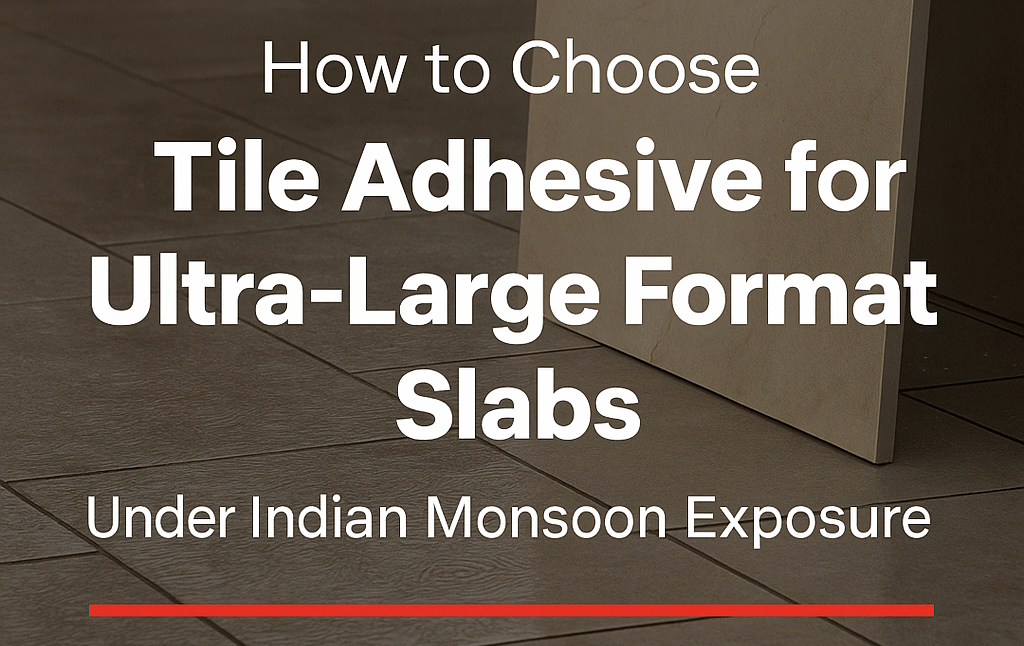How to Choose Tile Adhesive for Ultra-Large Format Slabs Under Indian Monsoon Exposure
Tiling with ultra-large format slabs has become a major trend in Indian architecture. From luxury living rooms to commercial lobbies and exterior facades, these large tiles create a seamless, modern look. But installing them isn’t as simple as it looks — especially when your project has to withstand heavy rainfall, humidity, and temperature swings during the Indian monsoon. That’s where choosing the right tile adhesive becomes crucial.
Common Question Asked:
Q1: Can regular tile adhesive handle large-format slabs in monsoon conditions?
No. Large slabs need specialized polymer-modified, waterproof tile adhesives that can resist moisture, thermal movement, and structural stress.
Why Large-Format Slabs Need Special Adhesive
Large-format tiles — usually 600×1200 mm or bigger — have very low porosity and high weight. This means they require adhesives with excellent bond strength, flexibility, and coverage to prevent failures.
During the monsoon, moisture can seep behind tiles, causing swelling, cracks, or debonding. Traditional cement-sand mixes or low-grade adhesives simply can’t handle this combination of load and humidity.
A polymer tile adhesive offers superior adhesion, flexibility, and water resistance — three must-have qualities for monsoon-exposed installations.
Key Challenges During Monsoon Installation
- High Moisture & Damp Substrates: Rain-soaked surfaces reduce adhesion.
- Thermal Movement: Temperature shifts cause tile expansion and contraction.
- Delayed Curing: Excess humidity slows down drying.
- Efflorescence & Staining: Water seepage pushes salts to the tile surface.
- Structural Vibration: Common in high-rises or outdoor areas.
Using the right outdoor tile adhesive helps avoid these issues and ensures long-term durability.
Features to Look For in the Right Tile Adhesive
When selecting the best tile adhesive for large-format slabs, consider these essential features:
1. Polymer Modification
Polymer-modified adhesives enhance flexibility and bonding. They allow slight tile movement without cracking — ideal for areas with thermal stress or structural load changes.
Redwop’s TERATILE PROLIX EXTRA is a great example of a polymer tile adhesive that performs exceptionally under changing weather conditions.
2. Waterproofing Performance
A waterproof tile adhesive prevents seepage, efflorescence, and surface stains caused by prolonged exposure to rain or humidity.
For outdoor balconies, terraces, and façades, adhesives like TERATILE PLATINUM offer strong water resistance and dependable bonding even on damp substrates.
3. Extended Open Time
Large tiles take longer to adjust and level, especially in humid conditions. Adhesives with extended open time allow better workability and positioning without losing bond strength.
4. Non-Shrink & Sag-Resistant Formula
For vertical installations or cladding, a non-slip, non-shrink adhesive is crucial to keep tiles in place during curing. This ensures even load distribution and prevents tile slippage.
5. Compatibility with Substrates
Ensure the adhesive bonds effectively with substrates such as:
- Reinforced concrete
- Plaster or cement boards
- Existing tile layers
- Waterproof coatings
Redwop adhesives are engineered to adhere to multiple substrates, making them versatile for both interior and exterior applications.
Best Practices for Installing Large-Format Tiles During Monsoon
1. Surface Preparation
- Clean and dry the substrate thoroughly.
- Remove dust, grease, or loose particles.
- If moisture is present, apply a primer or waterproof coating before laying tiles.
2. Correct Mixing Ratio
Follow the manufacturer’s guidelines for mixing. Adding too much water weakens bonding and increases curing time. Redwop adhesives are designed for smooth, lump-free mixing.
3. Use the Right Trowel Size
For large tiles, use a notched trowel (10–12 mm) to ensure full coverage. Back-buttering the tile is highly recommended for 100 % contact.
4. Allow Adequate Curing Time
Even with fast-setting adhesives, high humidity can delay curing. Avoid foot traffic or grouting for at least 24–48 hours after installation.
Redwop Tile Adhesives Recommended for Monsoon-Exposed, Large-Format Applications
- TERATILE PROLIX EXTRA: High-performance polymer-modified adhesive ideal for heavy stone, granite, and large slabs exposed to moisture or temperature changes.
- TERATILE PLATINUM: Designed for external cladding, terraces, and façades where water resistance and flexibility are critical.
- TERATILE GOLD: Teratile Gold is suitable for semi-exposed areas like balconies or wet interiors needing a waterproof, flexible bond.
Each of these products is tested for adhesion strength, deformability, and long-term durability — key factors for Indian monsoon conditions.
Common Installation Mistakes to Avoid
- Applying adhesive on wet or uneven substrates.
- Using cement-sand mortar instead of a proper adhesive.
- Skipping back-buttering on large slabs.
- Ignoring product data sheets.
- Rushing installation before full curing.
Avoiding these mistakes not only saves material costs but also prevents expensive rework or tile failure later.
Conclusion
Choosing the right tile adhesive for large-format slabs during India’s monsoon season is all about balancing strength, flexibility, and waterproofing. Ordinary products may work temporarily, but only high-quality polymer-modified adhesives ensure lasting performance.
Whether it’s a commercial façade, terrace, or living room flooring, Redwop’s TERATILE PROLIX EXTRA and TERATILE PLATINUM deliver the reliability professionals need under extreme weather conditions.
Investing in the right waterproof tile adhesive today means a flawless, worry-free installation that lasts for years — rain or shine.
FAQs:
-
1. Which tile adhesive is best for large-format slabs during the monsoon?
Redwop’s TERATILE PROLIX EXTRA offers superior polymer bonding and water resistance, ideal for outdoor and heavy tile applications.
-
2. Can I use indoor tile adhesive for outdoor installations?
No. Always choose an outdoor tile adhesive specifically designed for withstanding moisture, temperature fluctuations, and UV exposure.
-
3. Why is polymer modification important in tile adhesives?
Polymer additives improve flexibility and adhesion, preventing cracks due to tile movement or structural stress.
-
4. Do I need waterproof adhesive even if I have waterproof flooring?
Yes. A waterproof tile adhesive adds an additional layer of protection and prevents seepage through joints.
-
5. How long should I wait to grout after fixing tiles?
Allow at least 24 to 48 hours for curing before grouting, depending on humidity and temperature levels.



